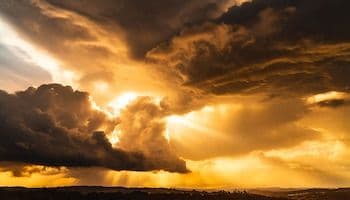Santiago's Thirsty Wait: Unpacking the Elusive Winter Rains
Santiago awaits crucial winter rain as forecasts shift. Delve into Chile's complex weather patterns, understanding why capital showers are elusive amidst regional storms.
The Anticipation Game: A Capital's Dry July
, a city nestled in Chile's arid central zone, has been gripped by a peculiar form of winter anxiety this July: the elusive promise of rain. As the month draws to a close, the capital has largely remained parched, a stark contrast to the typical expectations of a Southern Hemisphere winter. Initial forecasts had teased the possibility of widespread precipitation around July 24th and 25th for the Metropolitan Region. However, these hopes were quickly dampened as updated predictions indicated only isolated showers for specific outlying communes like San José de Maipo, Buin, or Paine, leaving the core city center frustratingly dry. The public's keen watch on the skies reflects a deeper concern, as this July has proven exceptionally dry compared to previous years. Even the most optimistic updates, such as meteorologist 's prediction for July 27th, offered only a faint glimmer of hope: a mere one millimeter of rain, barely enough to wet the pavement, possibly limited to Santiago's eastern and southern sectors. This ongoing 'will it or won't it' weather narrative highlights the capital's ongoing struggle with water scarcity, making every forecast a high-stakes game for residents and authorities alike.
Behind the Forecasts: Decoding Meteorological Nuances
The shifting meteorological predictions aren't merely a matter of caprice; they reveal the intricate and often frustrating complexity of forecasting for Chile's central zone. What seemed like a straightforward frontal system advancing from the south proved to be a fickle visitor, stalling tantalizingly at the border of the O’Higgins Region. This subtle shift, just a few kilometers, was enough to deny Santiago the anticipated rainfall on its initially predicted dates. According to the , the day that was supposed to bring widespread showers instead saw persistent cloud cover that eventually gave way to clear skies, without a single drop. Expert meteorologists, like TVN's , grapple with these fine margins daily. His revised outlook, hinting at a slightly more substantial 5 to 8 millimeters of rain for the following week (likely Tuesday or Wednesday), underscores the dynamic nature of these systems. It's a constant recalibration, where subtle atmospheric pressure changes and frontal movements dictate whether a city experiences a much-needed downpour or another day under a stubbornly clear sky, emphasizing the delicate balance that governs Santiago's winter weather patterns.
Santiago's Scant Showers: A Regional Contrast
While endures its 'thirsty wait' for even a few millimeters of rain, other parts of Chile are bracing for, or already experiencing, far more dramatic weather events. The narrative of Santiago's scant showers stands in stark contrast to the intense frontal systems and powerful extratropical cyclones that have been sweeping across other regions. News headlines speak of a 'calm before the storm' for some, while others grapple with conditions severe enough to bring rain and snow to as many as eleven regions, alongside intensely cold polar air masses, with temperatures plummeting to -10°C in some areas. This highlights a significant meteorological divide across the country. Santiago, despite being in the heart of winter, appears to be consistently bypassed by the most robust precipitation events, receiving only the weakest remnants or nothing at all. This regional disparity underscores the unique atmospheric blocking patterns or topographical influences that seem to consistently divert significant moisture away from the capital, leaving it an anomaly in a winter marked by more widespread and impactful weather across the rest of the nation.
Winter's Whim: Climate Trends and the Central Zone
[Santiago]'s exceptionally dry July isn't just an isolated weather anomaly; it's a symptom of broader, worrying climate trends affecting Chile's central zone. The persistent absence of significant winter precipitation raises serious questions about the long-term hydrological future of this densely populated region. Historically, winters in central Chile, fueled by frontal systems originating from the Pacific, were critical for replenishing water reserves in the Andes, which then supply the capital's rivers and reservoirs. However, over recent decades, the central zone has experienced a pronounced mega-drought, and this dry July only reinforces the ongoing pattern of reduced rainfall. Meteorologists' constant adjustments to forecasts, from promising showers to barely a drizzle, reflect not just the challenge of prediction, but the underlying reality of less frequent and less intense systems making their way inland. This shifting climate pattern means that the very mechanism of winter rain delivery is becoming less reliable, transforming what was once a seasonal certainty into an increasingly unpredictable 'winter's whim.' Understanding these macro-level climate shifts is crucial for appreciating the gravity of Santiago's current parched state.
More Than Just Drops: The Significance of Santiago's Rain
For , a few millimeters of rain are far more than just drops; they are a lifeline. The intense public and media focus on every shifting forecast, and the detailed analysis of whether a frontal system will deliver one, five, or eight millimeters, underscores the profound significance of winter precipitation for the capital's future. Santiago relies heavily on snowmelt from the Andes and the rain that replenishes rivers and groundwater for its domestic, agricultural, and industrial needs. A prolonged dry spell, like the one experienced this July, directly impacts water security, exacerbating concerns about the city's long-term water supply. Beyond utility, rain also plays a crucial role in clearing Santiago's notoriously polluted air, washing away particulate matter that accumulates during dry, calm periods. Therefore, the anticipation for even weak showers isn't just about a break from the dryness; it's a collective yearning for ecological balance, a cleaner environment, and reassurance regarding the fundamental resource that underpins the city's very existence. The 'thirsty wait' is a poignant reminder of Santiago's vulnerability to climate change and the critical importance of every single drop.
Related Articles

From Humid Hues to Winter Whispers: Decoding Rosario's Climate Story

From Humid Hues to Winter Whispers: Decoding Rosario's Climate Story

Beyond the Thermometer: How Argentina's Weather Watchdog Shapes a Nation's Winter Response

Beyond the Thermometer: How Argentina's Weather Watchdog Shapes a Nation's Winter Response

When Winter Feels Like Summer: Unpacking Tucumán's Climate Paradox

When Winter Feels Like Summer: Unpacking Tucumán's Climate Paradox

The Daily Dial: Decoding the Earth's Shifting Moods in Your Local Forecast
